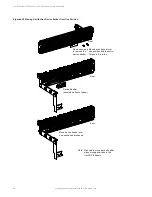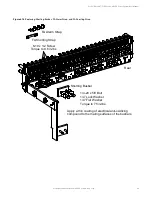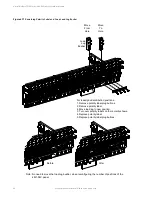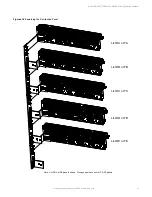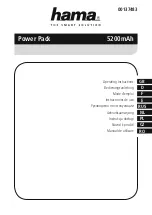
Vertiv™ NetSure™ 5100 Series -48 VDC Power System User Manual
Proprietary and Confidential © 2022 Vertiv Group Corp.
40
If a rectifier, -48 VDC to +24 VDC converter, or -48 VDC to -58 VDC converter module is removed from the system (and the Rect
Comm Fail or Conv Comm Fail alarm is cleared); the respective current limit point will remain unchanged unless the capacity of the
remaining rectifiers, -48 VDC to +24 VDC converters, or -48 VDC to -58 VDC converters is not sufficient to maintain this current limit
point. If that happens, the current limit point will automatically decrease to the maximum (121% of the remaining rectifiers or 116% of
the remaining -48 VDC to +24 VDC converters or -48 VDC to -58 VDC converters).
It is recommended that the current limit point be checked whenever a rectifier, -48 VDC to +24 VDC converter module, or -48 VDC to
-58 VDC converter module is added to or removed from the power system.
When setting total rectifier or total -48 VDC to +24 VDC converter or -48 VDC to -58 VDC converter current limit, the set point to
each unit is the total set point divided by the number of units. For example, if the system contains five rectifiers and the current limit
is set to 150 amps then each rectifier has a current limit set point of 30 amps. If one or more rectifiers or -48 VDC to +24 VDC
converters or -48 VDC to -58 VDC converters are removed or fails, it will take several seconds for the individual set points to the
remaining rectifiers or -48 VDC to +24 VDC converters or -48 VDC to -58 VDC converters to be reset. In the example given, if one
rectifier is removed the current limit set point will drop to 120 amps (30 amps times four remaining rectifiers) until the controller can
send updated set points to the remaining rectifiers. This takes a couple communication cycles (several seconds) after which each
rectifier would have a new set point of 37.5 amps for a total of 150 amps. The total current limit of the rectifiers and -48 VDC to
+24 VDC converters or -48 VDC to -58 VDC converters should not be set such that the loss of the redundant rectifiers or -48 VDC to
+24 VDC converters or -48 VDC to -58 VDC converters will cause this temporary set point to drop below the actual maximum
expected load. If batteries are used on the rectifier output, the batteries should support the load until the current limit set points can
be re-established due to loss of a rectifier.
Refer to the NCU Instructions (UM1M830BNA) for a procedure.
Clearing a Rectifier Communications Fail Alarm after Removing a Rectifier
If a rectifier module is removed from the system, a rectifier communications failure alarm is generated. If the rectifier module will not
be replaced, the alarm should be cleared.
Refer to the NCU Instructions (UM1M830BNA) for a procedure.
Clearing a Solar Converter Communications Fail Alarm after Removing a Solar Converter
If a solar converter module is removed from the system, a solar converter communications failure alarm is generated. If the solar
converter module will not be replaced, the alarm should be cleared.
Refer to the NCU Instructions (UM1M830BNA) for a procedure.
Clearing a -48 VDC to +24 VDC Converter or -48 VDC to -58 VDC Converter Communications Fail Alarm
after Removing a -48 VDC to +24 VDC Converter or -48 VDC to -58 VDC Converter
If a -48 VDC to +24 VDC or a -48 VDC to -58 VDC converter module is removed from the system, a converter communications failure
alarm is generated. If the converter module will not be replaced, the alarm should be cleared.
Refer to the NCU Instructions (UM1M830BNA) for a procedure.
Clearing an Inverter Communications Fail Alarm after Removing an Inverter
If an inverter module is removed from the system, an inverter communications failure alarm is generated. If the inverter module will not
be replaced, the alarm should be cleared. Refer to the NCU Controller Instructions (UM1M830BNA) for a procedure.
Clearing a Rectifier Lost Alarm
If the controller resets while a rectifier communications fail alarm is active, the rectifier communications fail alarm is replaced with a
rectifier lost alarm.
Refer to the NCU Instructions (UM1M830BNA) for a procedure to clear the alarm.



